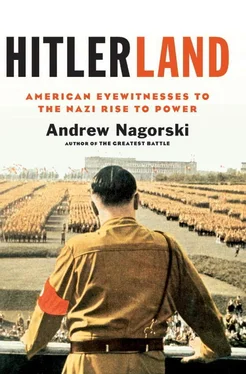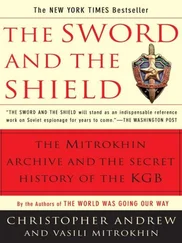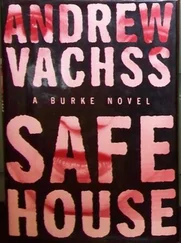Confessing that she was nervous enough about this encounter to consider taking smelling salts, she waited impatiently in the Kaiserhof Hotel for Hitler to arrive. He did so an hour late, and then kept her waiting in Putzi’s room even longer. Thompson related all this, keeping the reader in suspense as well. But not for long. With a dramatic flourish, she allowed the reader to accompany her not just into her meeting but also into her mind. “When finally I walked into Adolph Hitler’s salon in the Kaiserhof Hotel, I was convinced that I was meeting the future dictator of Germany,” she wrote. “In something less than fifty seconds I was quite sure I was not. It took just that long to measure the startling insignificance of this man who has set the world agog.
“He is formless, almost faceless, a man whose countenance is a caricature, a man whose framework seems cartilaginous, without bones,” she continued. “He is inconsequent and voluble, ill-poised, insecure.” Then, referring to the title of a bestselling novel of that era by German writer Hans Fallada, she added: “He is the very prototype of the Little Man.”
In quick brush strokes, she completed the physical portrait of Hitler: the lock of hair falling over “an insignificant and slightly retreating forehead,” a large nose “badly shaped and without character,” and his movements “awkward, almost undignified and most un-martial.” But his eyes, she pointed out, were notable, because “they have the peculiar shine which often distinguishes geniuses, alcoholics, and hysterics.” At the same time, she confessed he had “the soft, almost feminine charm of the Austrian!”
She contrasted his “actor’s face… capable of being pushed out or in” to President von Hindenburg’s face “cut out of rock” and Chancellor Brüning’s “head of an eighteenth century cardinal-statesman.” This caused her to involuntarily smile and think, “Oh, Adolph! Adolph! You will be out of luck!”
As Thompson also pointed out, the interview itself was difficult, since Hitler, as usual, spoke as if he were addressing a mass meeting. But it wasn’t the content of her interview that was important; it was her reading of the man and his prospects. While she dutifully marched the reader through his ideas as he spelled them out in the interview and in Mein Kampf (“The Jews are responsible for everything,” as she summed it up—adding “take the Jews out of Hitler’s program, and the whole thing… collapses”), the real message was her conclusion that “Hitler’s tragedy is that he has risen too high.” Her prediction: “If Hitler comes into power, he will smite only the weakest of his enemies.” In that case, she concluded, the key question would be who would come after him.
American readers probably found Thompson’s descriptions and conclusions reassuring. After all, the message was that, in all likelihood, Hitler would never make it to the top—and, if he did, it would be only for a brief, ineffective moment. When I Saw Hitler! was published, Nazi activist Kurt Ludecke, who shared Putzi’s ambitions to educate Hitler about the United States and saw the press chief as a pompous fool, told the Nazi leader that he was going to quote him something from “Mrs. Lewis, the wife of one of America’s most famous novelists.” He then translated the part about how quickly she had realized that he wasn’t going to take power.
“Who is this Mrs. Lewis anyway?” Hitler asked. Ludecke explained that she was Dorothy Thompson, the correspondent Putzi had brought to him. “ Ja, ja , now I remember,” Hitler replied. “Hanfstaengl again! He brought this woman to me…”
But Hitler seemed more amused than irritated by Thompson’s conclusions, much to the disappointment of Ludecke. In fact, he had good reason to welcome and encourage any coverage that downplayed the threat he represented—and he usually did so with Americans when Hanfstaengl was the facilitator, taking advantage of his American and, on occasion, Harvard ties.
One of Putzi’s classmates and best friends at Harvard was Hans V. Kaltenborn, who would become a nationally famous radio broadcaster. The son of German immigrants who had settled in Milwaukee, he learned German at home, and in college he became the vice president of the Deutscher Verein, the German Union, while Putzi served as its president. In the 1920s, Kaltenborn visited Europe often and, in Germany, Hanfstaengl arranged for him to meet various Nazis. But he hadn’t met Hitler, since he was rarely willing to spend much time waiting around for a possible interview. As Kaltenborn recalled, though, Putzi “felt that any newspaper correspondent or radio commentator should be willing to waste at least a week in prayerful hope that the Führer might condescend to receive him.”
But on August 16, 1932, while he was visiting Berlin, Kaltenborn received a telegram from his old classmate, who was in Munich, informing him that an interview was arranged for the next day in Berchtesgaden, Hitler’s Alpine retreat. Louis Lochner, the Associated Press bureau chief in Berlin, called him to let him know he had received a similar telegram so they would be going together. The two took the night train to Munich, and Putzi met them at the station. Both journalists were disappointed to learn from him that Wiegand, the Hearst correspondent, would also be included. The session felt less and less exclusive.
Putzi had arranged for Hitler’s car and driver to take them to Berchtesgaden. Once they arrived, they were treated to lunch on the terrace of a little hotel, while Putzi went over to Hitler’s “Swiss chalet,” as Kalten-born called it. Wiegand had argued that he had to have a separate interview, and the two other journalists were pleased when Putzi managed to arrange this. They were even happier when the Hearst correspondent angrily returned from a mere fifteen minutes with Hitler. “That man is hopeless,” he told them. “He gets worse every time I see him. I get nothing out of him. Ask him a question and he makes a speech. This whole trip has been a waste of time.”
Kaltenborn took that as a lesson and decided that he would confront Hitler immediately about his feelings about the Jews. “Unlike Lochner, I wasn’t stationed in Germany and did not need to be discreet to escape expulsion,” he noted later. They walked over to Hitler’s house, and their host, dressed all in black, including his tie, came out to meet them. Hitler’s laundry, hung out by his half-sister Angela, was fluttering in the breeze, the view of the Bavarian Alps was majestic, and despite a few Nazi guards stationed on the paths outside, “everything suggested peace,” Kaltenborn noted. But he also felt an atmosphere of “latent hostility” when Putzi whispered to Hitler who they were.
As soon as they sat down, Kaltenborn fired off his first question: “Why does your anti-Semitism make no distinction between the Jews that flooded into Germany during the postwar period and the many fine Jewish families that have been German for generations?”
“All Jews are foreigners,” Hitler shouted back. “Who are you to ask me how I deal with foreigners. You Americans admit no foreigner unless he has good money, good physique, and good morals. Who are you to talk about who should be allowed in Germany?”
From then on, Kaltenborn continued tossing in as pointed questions as possible, while Lochner focused on more tactical queries about Hitler’s next political moves. As Kaltenborn noted, Hitler didn’t really answer his questions, no more than the first one, since “he has no capacity for logical consecutive thought.” As usual, he denounced the parliamentary system that, he argued, “has never functioned in Europe,” and called for authoritarian rule. He expected to take power, he maintained, but with the support of the German people. “A dictatorship is justified once the people declare their confidence in one man and ask him to rule,” he insisted.
Читать дальше











